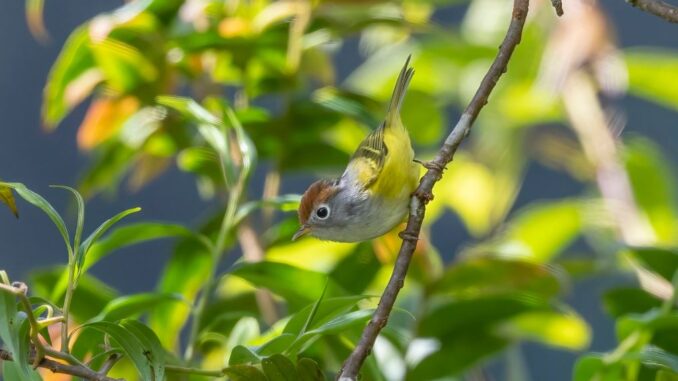
YEN BAI – Le Khac Quyen spent three days experiencing bird photography in the mountains of Mu Cang Chai.

Le Khac Quyen, 28 years old, living in Hanoi, started shooting more than 5 years ago and found an endless passion for wildlife photography, especially birds. Quyen’s main work is wildlife research and conservation in Vietnam, he is currently the secretary of the Vietnam Association for the Study and Conservation of Wild Birds (VBCS). To date, he has captured about 500 species of birds in the water.
Just last January, Quyen, and his photography-loving friends had a spring trip and discovered Mu Cang Chai, Yen Bai to photograph birds.

The mountain landscape taken on January 28 belongs to the Mu Cang Chai species and habitat conservation area, located in the communes of Che Tao, Nam Khat, Pung Luong, Lao Chai, and De Xu Phinh, about a distance from Mu Cang Chai town. 10 km. This reserve has a total area of about 20,300 hectares, is an arc formed by a high mountain system of 1,500 – 2,300 m. Due to its relatively high altitude, visitors can feel the cold even on warm sunny days. Photo: Thomas Mourez

Located on the Hoang Lien Son mountain range, the mountainous area of Mu Cang Chai is considered the most beautiful primeval forest with high biodiversity. This place also has many species of broad-leaved, coniferous trees and rich and endemic flora and fauna such as fern, rhododendron, oak, jet black gibbon or gray langur. On the photo is an old rhododendron covered with moss and forest orchids on the mountainside. Photo: Le Khac Quyen

Mu Cang Chai has a diverse and unique bird system of the Northwest with nearly 140 species, many rare and endemic birds. Some species of birds can only be found here and are hard to find anywhere else. Visitors can find a number of species such as the black-headed bush sparrow, brown-breasted reed, black-headed pine sparrow, white-throated larva in apple orchards and upland fields at an altitude of 1,200 m.
Continue to explore to an altitude of about 1,600 – 1,800 m, visitors will encounter birds such as big-billed crested (pictured), mountain branches, apricot blossom, big larks or red-headed flycatchers. The large beaked salute has a yellow-green body, a gray head with a high, forward curved crest. The beak is large and ivory white, living in large groups. Photo: Le Khac Quyen

The red-breasted groundhog was photographed at an altitude of about 1,700 m, this shy bird usually feeds singly or in pairs. They are brown with a red beak. The face is black with eyebrows and a white throat.
Quyen said: “I stayed here for 3 days. Early in the morning with a little dew and sunlight shining through the gaps in the leaves, I walked on the road leading up to the wind pass, walking slowly and listening to the birds. Photo: Le Khac Quyen

Pictured is the long-tailed tit , a small bird with a reddish forehead with black-streaked throat and cheeks, a white neck cavity and an orange rim on the thorax extending under the wings.
“This is probably the most beautiful bird in the jungle, no one comes to take pictures of birds in Mu Cang Chai without paying attention to this small bird with a lovely face. They often go in large groups and call each other, which can be seen at an altitude of 1,800 m,” he shared. Photo: Le Khac Quyen

The altitude from about 1,800 m or more is also home to the most precious treasures of life, including the bald-headed flycatcher. This is a small bird about 10 cm, with bright and colorful colors, always active jumping very fast. Photo: Le Khac Quyen

The Nepalese honeyeater is a brightly colored honeyeater with a light green head and tail, dark red upperparts, and bright yellow underparts. Photo: Le Khac Quyen

Climbing an ass-hung tree is only distributed in the Northwest and Central Highlands. They are gray on the back and white on the belly, with a thin black streak extending from the base of the beak to the shoulder. This bird can be identified by the dark tawny parts on the flanks and under the tail with scaly markings. Photo: Le Khac Quyen

An area of 1,800 – 2,300 m is where some rare bird species can be found such as the small penguin, Yunnan striped-tailed babbler, black-chinned flat-billed babbler, red-faced babbler, and short-tailed babbler (endemic to Vietnam) or babbler. Gray throat soil is very narrowly distributed and rare.
Living alone, quietly under the shrubs at an altitude of about 2,000 m is a small, short-tailed babbler (pictured) with a tiny size like a jackfruit seed, a brown back with a lighter abdomen that helps them easily camouflage and hide. hidden. The right to record them on the first day, but on the last day before returning, I was lucky to take a satisfactory series of pictures of this species. Photo: Le Khac Quyen

The Black-chined Flat-billed Babbler is a large-sized species of the flat-billed babbler group with a yellow bill, large black feathers on the cheeks, tawny crown, and black-streaked thorax. During the breeding season, they usually come in pairs. Photo: Le Khac Quyen

The Yunnan Striped Babbler is a medium-sized bird, easily recognized by its light brown body with numerous black stripes on the wings and tail feathers. They usually go in small groups or sometimes meet in pairs to forage together.
“The Yunnan striped-tailed babbler doesn’t impress me with its looks, but the act of flirting with a mate and standing next to each other, full of love, evokes a little bit of love,” he said. Photo: Le Khac Quyen
Follow (vnexpress)
